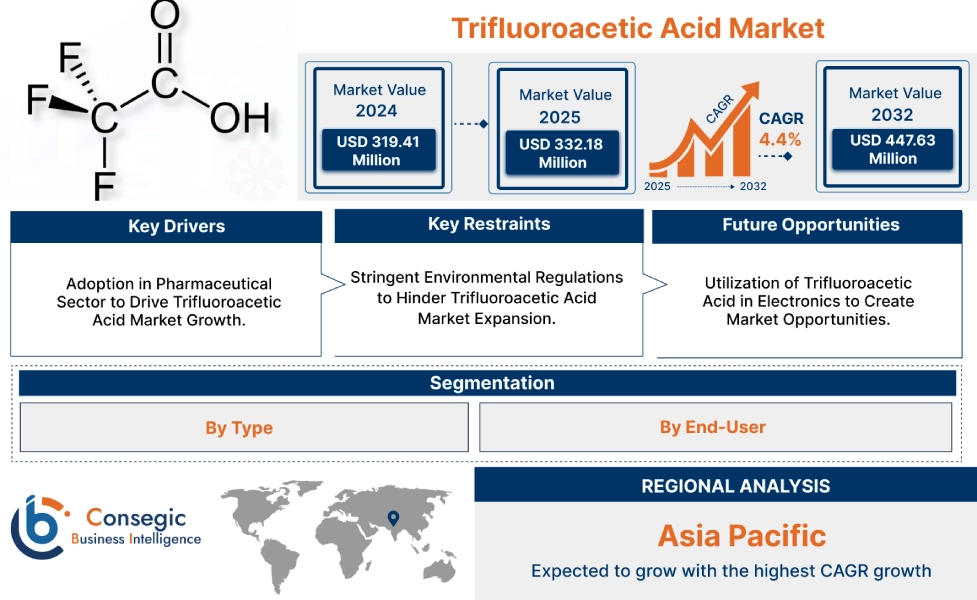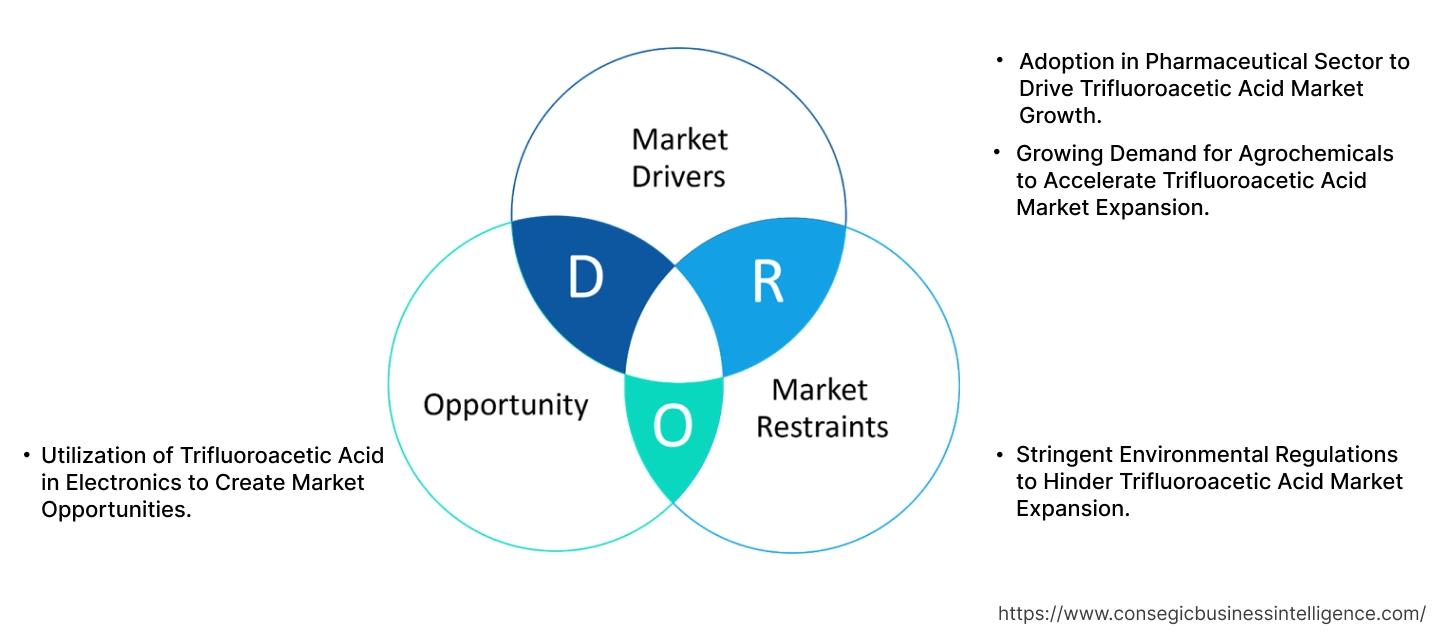Trifluoroacetic Acid Market Size:
The Trifluoroacetic Acid Market size is growing with a CAGR of 4.4% during the forecast period (2025-2032), and the market is projected to be valued at USD 447.63 Million by 2032 from USD 319.41 Million in 2024. Additionally, the market value for 2025 is attributed to USD 332.18 Million.
Trifluoroacetic Acid Market Scope & Overview:
Trifluoroacetic acid (TFA) is a synthetic organofluorine compound which is a strong monocarboxylic acid due to the electron-withdrawing effect of its three fluorine atoms. It appears as a colorless, fuming liquid with a pungent odor and is highly soluble in both water and many organic solvents. The compound's high acidity, volatility, and solubility make it a suitable reagent in organic synthesis such as for removing protecting groups in complex chemical reactions and peptide synthesis. Furthermore, it serves as a crucial intermediate in the manufacturing of fluorine-containing pharmaceuticals and agrochemicals and is widely used as an ion-pairing agent for analytical chemistry.
How is AI Transforming the Trifluoroacetic Acid Market?
AI is influencing the trifluoroacetic acid (TFA) market by optimizing production efficiency, process safety, and supply chain management. In chemical manufacturing, AI-driven predictive models monitor reaction parameters and chemical interactions to ensure consistent yield and purity while minimizing waste. Machine learning enhances process control, detecting anomalies early to prevent equipment failures or hazardous conditions. AI also supports demand forecasting and inventory optimization, helping manufacturers align production with market needs. In research and pharmaceutical applications, AI accelerates the development of new synthesis methods involving TFA by simulating reactions digitally. As industries move toward smarter and more sustainable chemical processes, AI is driving innovation, cost reduction, and operational reliability in the global TFA market.
Trifluoroacetic Acid Market Dynamics - (DRO) :
Key Drivers:
Adoption in Pharmaceutical Sector to Drive Trifluoroacetic Acid Market Growth.
Trifluoroacetic acid serves as a crucial compound for development, manufacturing, and research in pharmaceuticals. Specifically, it is used in the development of complex compounds, pharmaceutical intermediates, oncology active pharmaceutical ingredients (API) , amongst others. Essentially it serves a critical role in peptide synthesis for removing protecting groups. The constantly expanding pharmaceutical landscape globally, fueled by continuous R&D, positively impacts market demand.
- For instance, according to the EFPIA, EU pharmaceutical R&D spending experienced an average annual growth of 4.4% between 2010 and 2022.
Thus, the growing adoption of the compound in the pharmaceutical sector is driving the trifluoroacetic acid market growth.
Growing Demand for Agrochemicals to Accelerate Trifluoroacetic Acid Market Expansion.
Trifluoroacetic acid is widely used as key building block and intermediate in the synthesis of several agricultural chemicals such as herbicides, fungicides, and insecticides. The global need to enhance agricultural productivity and combat crop losses due to pests and diseases is rising. This drives continuous innovation and production of new agrochemicals leveraging the unique properties offered by fluorine atoms.
- For instance, the data by FAO, states that in 2022 total pesticide use in agriculture reached 3.70 Billion tons across the globe, marking a 4% increase compared to 2021.
Consequently, the reliance of the agrochemical sector on the compound to create these essential fluorine-containing agrochemicals directly results in sustained need for the compound, propelling its market growth.
Key Restraints:
Stringent Environmental Regulations to Hinder Trifluoroacetic Acid Market Expansion.
The market faces a significant constraint on its upward trajectory due to the increasing environmental concerns and stringent regulatory oversight. Due to its formation as a breakdown product of widely used refrigerants, pesticides and pharmaceuticals among others, trifluoroacetic acid is a known and growing contaminant in water and soil. This is resulting in a strong emphasis on environmental preservation which in turn is prompting regulatory bodies to consider stricter limitations on its precursors and direct emissions. Compliance with these evolving environmental standards, including advanced waste disposal and treatment technologies, significantly increases production costs for key players. The managing and processing of trifluoroacetic acid -containing waste is of complex nature and difficult to remove from water, requiring substantial capital investment. Consequently, this is leading to supply chain disruptions as manufacturing operations face closures or restrictions due to non-compliance, thereby limiting the market expansion.
Future Opportunities :
Utilization of Trifluoroacetic Acid in Electronics to Create Market Opportunities.
TFA finds growing applications in the electronics sector. Distinguished by its unique properties including its strong acidity, volatility, and ability to act as dry etching agent, make it suitable for manufacturing of advanced electronic components. It is being adopted particularly in the manufacturing of high-performance materials for semiconductors, flat panel displays, and other electronic components that present the need for precise etching or unique chemical properties. The expanding market for semiconductors further creates trifluoroacetic acid market opportunities globally.
- For instance, as per the analysis by the S. International Trade Commission , global semiconductor sales are projected to exceed USD 1 trillion by 2030, a substantial increase driven by adoption in key sectors such as computing and data storage, wireless communication, and automotive electronics.
As a result, this adoption in electronics manufacturing benefits the trifluoroacetic acid market demand.
Trifluoroacetic Acid Market Segmental Analysis :
By Form:
Based on form, the market is bifurcated into anhydrous trifluoroacetic acid and aqueous trifluoracetic acid.
Trends in the Form
- Increasing requirement for ultra-high purity anhydrous trifluoroacetic acid is a key trend driven by stringent requirements in pharmaceutical API synthesis and electronics manufacturing.
- Rise in complex peptide synthesis methods continue to rely heavily on anhydrous trifluoroacetic acid for efficient protecting group removal.
The anhydrous trifluoroacetic acid segment accounted for the largest trifluoroacetic acid market share in 2024 and is expected to grow at the fastest CAGR over the forecast period.
- Anhydrous form refers to TFA with extremely low or no water content. It is the most concentrated and reactive form occurring as a fuming liquid.
- For demanding applications such as the final cleavage step in solid-phase peptide synthesis, its anhydrous nature is critical in selectively removing protecting groups.
- The segment revenue is driven by its indispensable role and stringent purity requirements across these high-value, specialized industries such as pharmaceuticals, agrochemical synthesis, and electronics.
- For instance, as per data published by IBEF, India’s electronic manufacturing sector experienced significant growth, reaching USD 67.3 billion in 2020-21.
- Consequently, considering the aforementioned factors, the anhydrous form dominates the trifluoroacetic acid market demand.
By End Use:
The end use segment is categorized into chemicals, pharmaceuticals, agriculture, electronics, and others.
Trends in the End Use:
- Rising adoption of TFA in solid-phase peptide synthesis for novel drug development and therapeutic applications.
- Growing use of trifluoroacetic acid in the development and synthesis of specialized fluorinated materials for high-performance electronic components is a trend positively impacting the market.
The pharmaceuticals segment accounted for the trifluoroacetic acid market share of 39.82% in 2024.
- In the pharmaceutical sector, trifluoroacetic acidplays a crucial role through contribution to peptide synthesis.
- The compound enhances drug efficacy and stability, acting as key reagent in the synthesis of complex active pharmaceutical ingredients and various pharmaceutical intermediates.
- It's also used as an ion-pairing agent in HPLC for the purification and analysis of drugs and biological molecules.
- Robust R&D spending in the global pharmaceutical sector, the increasing complexity of drug molecules, and the rising demand for both generic and novel drugs are the factors contributing to the segment revenue.
- For instance, according toIFPMA on average, the global pharmaceutical sector allocated approximately 27% of its revenue to R&D efforts in 2021.
- As a result, as per the trifluoroacetic acid market analysis, the pharmaceuticals segment is dominating the trifluoroacetic acid market trends.
The electronics segment is expected to grow at the fastest CAGR over the forecast period.
- The electronics end-use sector segment within the market is projected to exhibit the rapid growth rate fueled by the growing adoption of TFA in the manufacturing processes for semiconductors and displays among other advanced electronic components.
- The compound finds use in specific dry etching processes, for cleaning reaction chambers, and as a solvent or surface treatment agent in semiconductor fabrication. Its high purity is essential here to prevent contamination.
- Additionally, miniaturization, and increasing demand for higher performance and purity in the global electronics and semiconductor industries are expected to fuel the segment revenue in the forecast years.
- Hence, as per analysis, the electronics segment is growing at the fastest rate in the upcoming years.
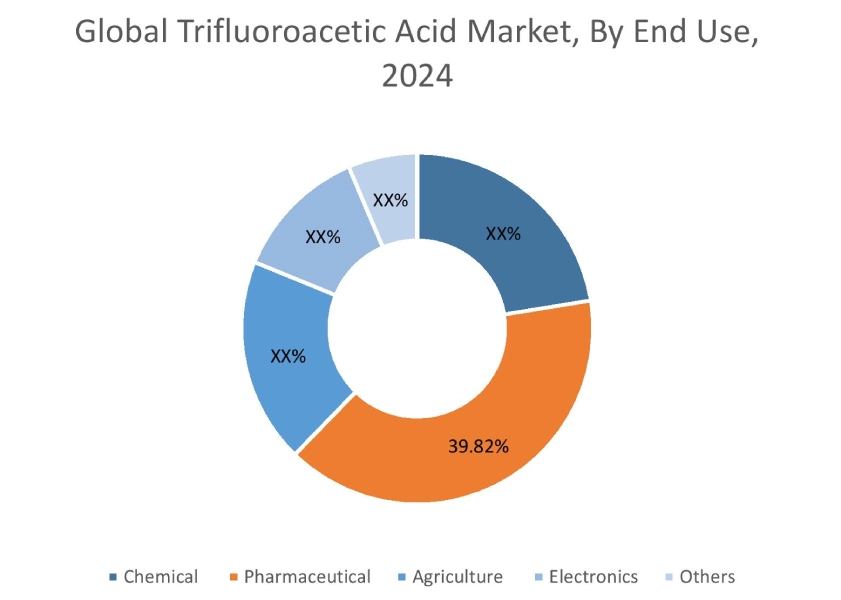
Regional Analysis:
The regional segment includes North America, Europe, Asia Pacific, the Middle East and Africa, and Latin America.
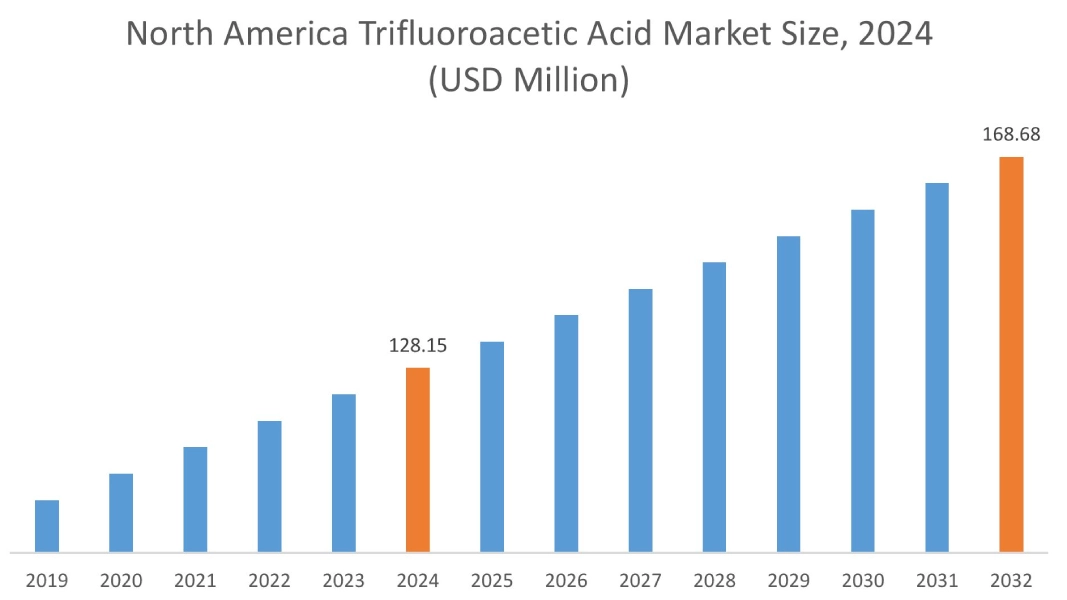
In 2024, North America accounted for the highest market share at 40.12% and was valued at USD 128.15 Million and is expected to reach USD 168.68 Million in 2032. In North America, the U.S. accounted for a market share of 72.55% during the base year of 2024. The North America market demand is significantly defined by a confluence of factors across key end-use sectors. In North America, the well-established pharmaceutical sector is a significant consumer of the compound utilizing it in the production of peptides crucial for drug development. The growing focus towards high-purity trifluoroacetic acid to meet stringent regulatory standards and the needs of advanced pharmaceutical and specialty chemical synthesis further propels the regional share.
- For instance, according to EFPIA, for new active substances launched globally, the United States continues to lead, accounting for 28 out of a total of 90 such launches.
This multifaceted adoption, coupled with the strong presence of agrochemical companies, positions North America as a significant market for the compound.
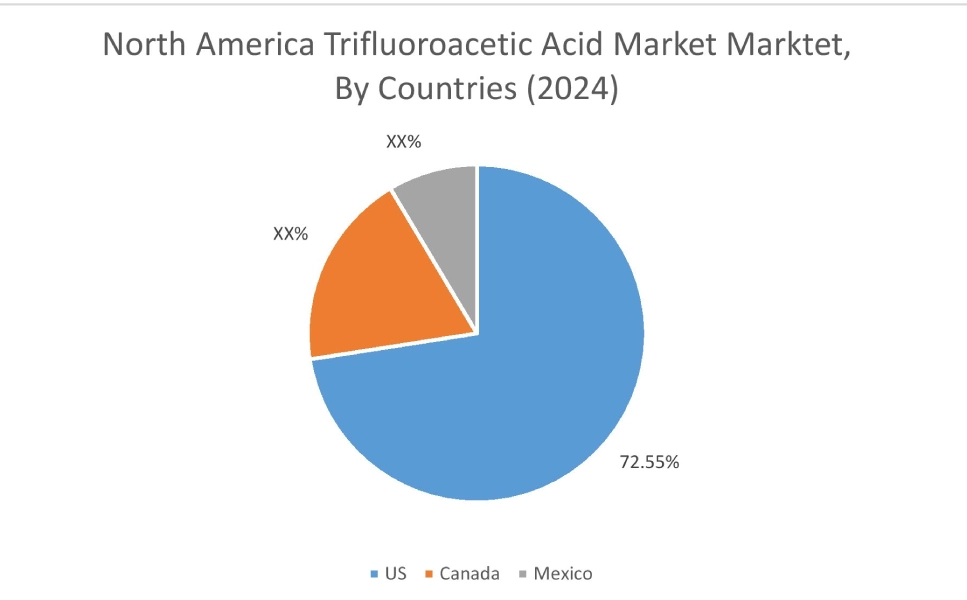
In Asia Pacific, the trifluoroacetic acid industry is experiencing the fastest growth with a CAGR of 5.8% over the forecast period owing to driven by its expanding electronics and chemical sectors. China is a major hub for both manufacturing, significantly fuels this requirement. In the electronics sector, this compound is crucial for advanced semiconductor manufacturing in the region's growing production of high-tech devices. Concurrently, the robust chemical sector in APAC utilizes the compound extensively as a key reagent, catalyst, and solvent for various organic syntheses, including the production of other specialized fluorinated chemicals.
In European market analysis, the region's robust pharmaceutical sector, characterized by extensive R&D and advanced manufacturing capabilities, drives substantial adoption of the compound in drug synthesis and analytical applications like HPLC. Similarly, its well-established agrochemical sector relies on TFA for producing advanced crop protection agents. Moreover, the presence of stringent environmental regulations across the European Union favors the use of bio-based and sustainable chemicals, further influencing the requirement and sourcing of the compound within the region. These factors collectively present a positive impact on the share of European market trends.
The Latin American trifluoroacetic acid market trend is primarily fueled by the expanding pharmaceutical and agrochemical sectors. The rising need for advanced healthcare, coupled with increasing investments in pharmaceutical R&D and manufacturing, drives the need for compound as a critical reagent. Simultaneously, the region's robust agricultural sector, aiming to boost productivity, utilizes the compound. As economies develop and regulatory frameworks for chemical safety become more stringent, Latin American countries are increasingly adopting higher-purity compound. Hence, these aforementioned factors are creating trifluoroacetic acid market opportunities in the region.
The trifluoroacetic acid market analysis in the Middle East and Africa (MEA) is currently witnessing growth driven by increasing investments in the region's pharmaceutical and chemical sectors, as well as a growing emphasis on enhancing agricultural output for food security. As these sectors develop, the adoption of high purity trifluoroacetic acid as a crucial intermediate in drug synthesis and agrochemical production is rising. Additionally, increasing health and safety awareness, coupled with a push for industrial diversification, contributes to the adoption of specialized chemicals across various applications in the MEA region.
Top Key Players and Market Share Insights:
The Global Trifluoroacetic Acid Market is highly competitive with major players providing products to the national and international markets. Key players are adopting several strategies in research and development (R&D) and product innovation to hold a strong position in the global Trifluoroacetic Acid market. Key players in the Trifluoroacetic Acid industry include
industry. Key players in the language learning industry include –- Merck KGaA (Germany)
- DAIKIN INDUSTRIES, Ltd. (Japan)
- Honeywell International Inc (U.S.)
- Midas Pharma GmbH (Germany)
- Solvay (Belgium)
- Halocarbon, LLC (U.S.)
- SRF Limited (India)
- Sinochem Holdings (China)
Recent Industry Developments :
Product Launches:
- In April 2025, Duolingo announced the release of 148 new language courses on the app. Moreover, Duolingo expands its access to widely held languages, including Spanish, Japanese, French, German, and others.
Trifluoroacetic Acid Market Report Insights :
| Report Attributes | Report Details |
| Study Timeline | 2019-2032 |
| Market Size in 2032 | USD 447.63 Million |
| CAGR (2025-2032) | 4.4% |
| By Form |
|
| By End Use |
|
| By Region |
|
| Key Players |
|
| North America | U.S. Canada Mexico |
| Europe | U.K. Germany France Spain Italy Russia Benelux Rest of Europe |
| APAC | China South Korea Japan India Australia ASEAN Rest of Asia-Pacific |
| Middle East and Africa | GCC Turkey South Africa Rest of MEA |
| LATAM | Brazil Argentina Chile Rest of LATAM |
| Report Coverage |
|
Key Questions Answered in the Report
How big is the Trifluoroacetic Acid market? +
In 2024, the Trifluoroacetic Acid market is USD 319.41 Million.
Which is the fastest-growing region in the Trifluoroacetic Acid market? +
The Asia Pacific is the fastest-growing region in the Trifluoroacetic Acid market.
What specific segmentation details are covered in the Trifluoroacetic Acid market? +
By Form and End Use segmentation details are covered in the Trifluoroacetic Acid market.
Who are the major players in the Trifluoroacetic Acid market? +
Merck KGaA (Germany), Solvay (Belgium), Halocarbon, LLC (U.S.) are some of the major players in the market.
